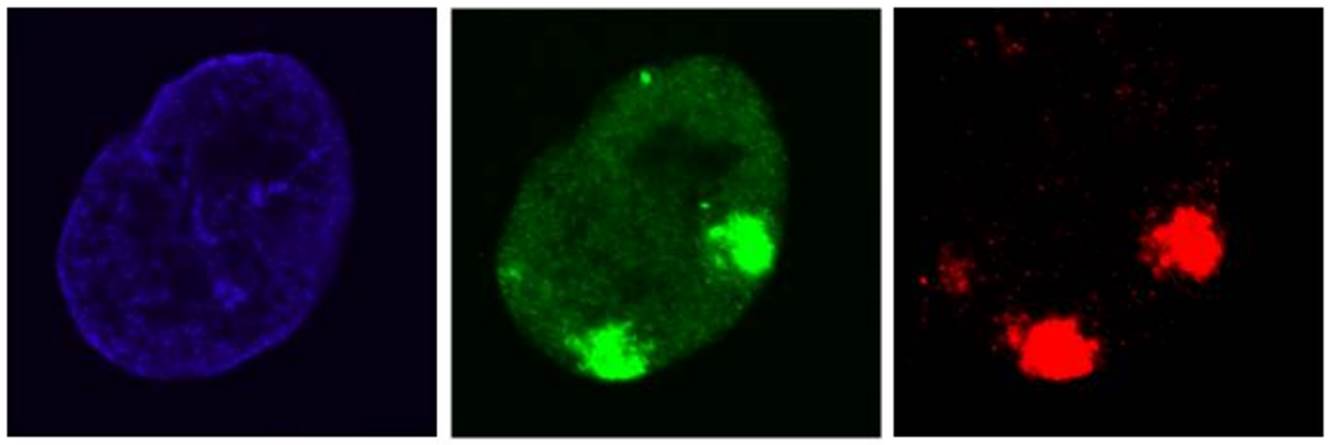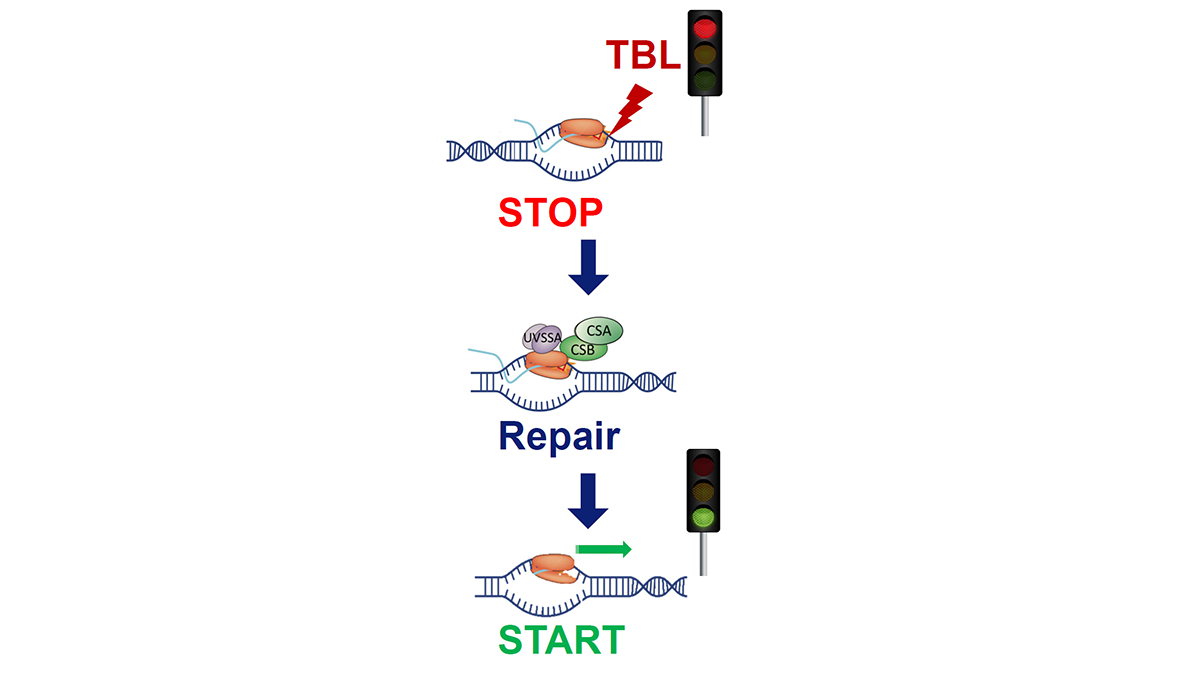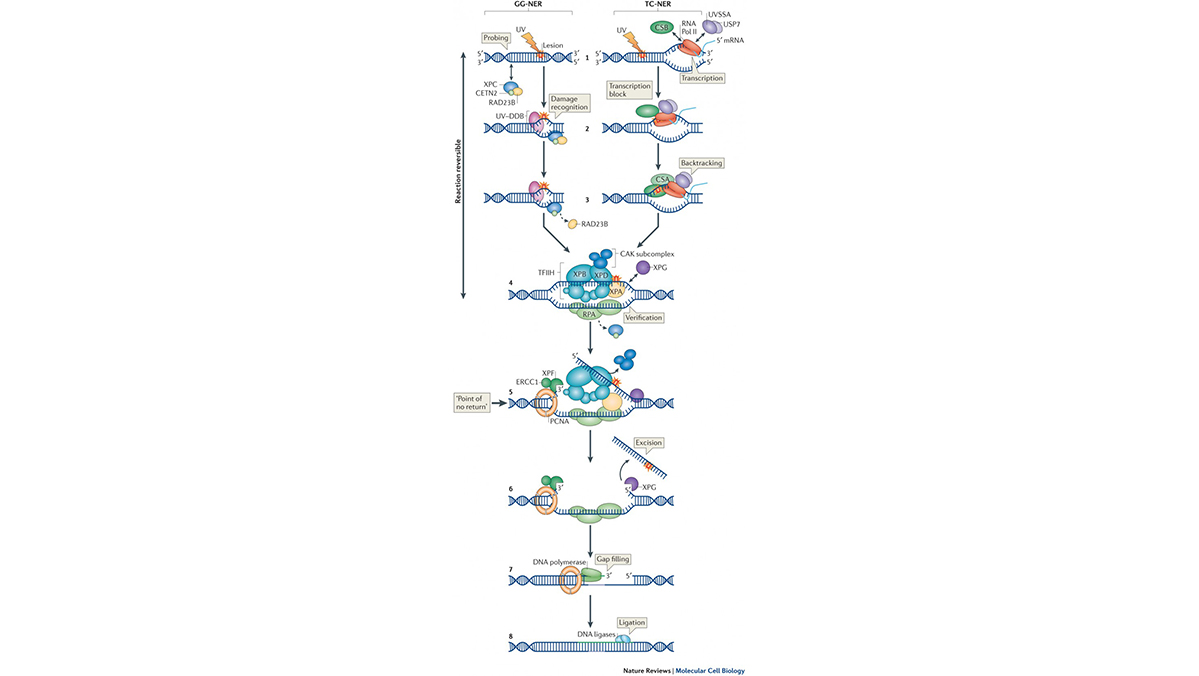About Prof. Dr. J. (Jurgen) Marteijn, PhD
Introduction
 Jurgen Marteijn received his MSc in Biotechnology (cum laude) at the Wageningen University (Wageningen, The Netherlands), with a cellular/molecular biology specialization. He obtained his PhD degree from the Radboud University Medical Center (Nijmegen, The Netherlands) in 2007, on the role of the ubiquitin proteasome pathway during haematopoiesis. Financed by personal Veni and Horizon grants and using the expertise acquired during my PhD, I studied the role of ubiquitylation in DNA-repair and DNA damage-associated signaling (Marteijn, JCB,2009 and van Cuijk, Nat.Com,2015), which finally resulted in the identification of the novel TCR factor UVSSA, which is mutated in the UV-sensitive syndrome (Schwertman,Nat.Gen,2012). This finding formed the scientific basis for my independent research group that studies how cells deal with transcription blocking DNA lesions (TBLs) and resulted in my appointment as associate professor in the Department of Molecular Genetics. My lab studies how TBLs are repaired and their consequences on transcription and DNA damage signaling.
Jurgen Marteijn received his MSc in Biotechnology (cum laude) at the Wageningen University (Wageningen, The Netherlands), with a cellular/molecular biology specialization. He obtained his PhD degree from the Radboud University Medical Center (Nijmegen, The Netherlands) in 2007, on the role of the ubiquitin proteasome pathway during haematopoiesis. Financed by personal Veni and Horizon grants and using the expertise acquired during my PhD, I studied the role of ubiquitylation in DNA-repair and DNA damage-associated signaling (Marteijn, JCB,2009 and van Cuijk, Nat.Com,2015), which finally resulted in the identification of the novel TCR factor UVSSA, which is mutated in the UV-sensitive syndrome (Schwertman,Nat.Gen,2012). This finding formed the scientific basis for my independent research group that studies how cells deal with transcription blocking DNA lesions (TBLs) and resulted in my appointment as associate professor in the Department of Molecular Genetics. My lab studies how TBLs are repaired and their consequences on transcription and DNA damage signaling.
Currently we focus how these processes, at the crossroads of transcription and repair, are regulated by post-translational modifications (PTMs) and protein-protein interactions in the context of chromatin using a combination of state-of-the-art live-cell imaging and quantitative proteomics. Recently we have shown that chromatin remodeling is an essential process during the restart of transcription upon TCR (Dinant,Mol.Cel,2013) and revealed that the spliceosome is a key target of the DDR and defines a R-loop-dependent ATM activation by transcription-blocking lesions as an important event in the DNA damage response (Tresini,Nature,2015). These findings, together with the acquired expertise and international collaborations, put me in the unique position to answer the highly relevant questions in the TCR field, as described in this proposal, and build a frame work on how organisms cope with the severe consequences of transcription blocking DNA damage.
Field(s) of expertise
Transcription Stress and Genome Stability
Unperturbed transcription of eukaryotic genes by RNA polymerase II (Pol2) is crucial for proper cell function. However, the DNA template of Pol2 is continuously challenged by damaging agents that can impede or block transcription. These transcription-blocking DNA lesions (TBLs) can cause Genoem stability, cellular dysfunction, senescence and apoptosis, eventually resulting in DNA damage-induced aging. Cells counteract these deleterious effects by transcription-coupled repair (TCR), which specifically removes TBLs thereby safeguarding transcription. My lab uses a combination of state-of-the-art live-cell imaging, advanced proteomic and genomic approaches to identify new proteins involved in this pathway and to obtain a better understanding of the molecular mechanism how cells cope with TBLs.

Research Introduction
The eukaryotic genome is transcribed by RNA polymerase 2 (Pol 2). Pol 2 mediated transcription is a tightly controlled process to ensure correct temporal and spatial regulation of gene expression, which is crucial for proper cell function. However, the DNA template that is transcribed by Pol 2 is compromised on a daily basis by numerous types of DNA-damaging factors. DNA damage can block or strongly impede Pol 2 mediated transcription. If these transcription-blocking DNA lesions (TBLs) are not properly resolved, this will severely disrupt cellular homeostasis due to the disturbed synthesis of new RNA molecules. In addition, TBLs may result in genome instability, severe cellular dysfunction or premature cell death, which finally may result in DNA damage-induced accelerated aging. Cells counteract these harmful effects by specifically removing TBLs by transcription-coupled repair (TCR), thereby safeguarding transcription. The severe developmental, neurological and premature aging features observed in patients with inherited TCR defects underscore the biological relevance of TCR and show the involvement of TBLs in the aging process.

The main research focus of my lab is to investigate the precise regulation and impact of TCR. Over the years, my lab has identified several factors that play important roles in this repair pathway. Although these studies resulted in new insights in the molecular mechanism of the TCR reaction itself, thus far surprisingly little is known about the regulation of transcription or what exactly happens with Pol 2 following the induction of transcription-blocking DNA damage. For example, the exact mechanisms how transcription is inhibited upon DNA damage, or how it is restarted following repair of the TBLs remains largely enigmatic. We use a combination of innovative live-cell imaging approaches with advanced proteomics and genomics approaches to identify new factors involved in the regulation of this pathway and to obtain a better understanding of the molecular mechanisms how cells cope with transcription blocking DNA damage.
DNA Damage and Repair
The mammalian genome is protected against genotoxic insults by a network of DNA-damage response (DDR) mechanisms including different DNA repair and damage signaling pathways, to remove lesions and to activate cell cycle checkpoints. Nucleotide Excision Repair (NER) is an important DNA repair mechanism able to remove a broad range of different types of helix-distorting DNA lesions. NER protects organisms against DNA damage-induced carcinogenesis and premature aging. Its significance is illustrated by the severe clinical consequences associated with inherited defects in NER. Genetic defects in NER give rise to various photo-sensitive syndromes, which include the cancer-prone disease Xeroderma Pigmentosum (XP), the premature ageing Cockayne’s Syndrome (CS), and the UV-sensitive syndrome (UVSS).
Transcription blocking DNA lesions (TBLs) cause cellular dysfunction, senescence and apoptosis, finally resulting in DNA damage induced aging. Cells counteract these deleterious effects by transcription-coupled repair (TCR), which removes RNA polymerase 2 (RNAP2) stalling DNA damage. The severe symptoms associated with inherited TCR defects underscore its importance to health but are strikingly diverse, ranging from mild photosensitivity to severe developmental, neurological and premature aging features. Even though TCR was discovered almost 3 decades ago, surprisingly little is known about the molecular consequence and fate of RNAP2 when stalled at different types of TBLs, how transcription is inhibited and subsequently restarted upon repair. Also why TBLs affect tissues differently and how this relates to aging remains enigmatic.
We apply a multidisciplinary approach to improve our understanding of the molecular mechanism of NER and the impact of NER on biological systems, working from the molecular genetic, biochemical and cell biological level to the level of intact eukaryotic organisms and patients.

Publications

KEY PUBLICATIONS
Lo CSY, van Toorn M, Gaggioli V, Paes Dias M, Zhu Y, Manolika EM, Zhao W, van der Does M, Mukherjee C, G S C Souto Gonçalves J, van Royen ME, French PJ, Demmers J, Smal I, Lans H, Wheeler D, Jonkers J, Chaudhuri AR, Marteijn JA, Taneja N.
SMARCAD1-mediated active replication fork stability maintains genome integrity.
Sci Adv. 2021 May 5;7(19):eabe7804.
Landsverk HB, Sandquist LE, Bay LTE, Steurer B, Campsteijn C, Landsverk OJB, Marteijn JA, Petermann E, Trinkle-Mulcahy L, Syljuåsen RG.
WDR82/PNUTS-PP1 Prevents Transcription-Replication Conflicts by Promoting RNA Polymerase II Degradation on Chromatin.
Cell Rep. 2020 Dec 1;33(9):108469.
Lans H, Hoeijmakers JHJ, Vermeulen W, Marteijn JA.
The DNA damage response to transcription stress.
Nat Rev Mol Cell Biol. 2019 Dec;20(12):766-784.
Wienholz F, Zhou D, Turkyilmaz Y, Schwertman P, Tresini M, Pines A, van Toorn M, Bezstarosti K, Demmers JAA, Marteijn JA.
FACT subunit Spt16 controls UVSSA recruitment to lesion-stalled RNA Pol II and stimulates TC-NER.
Nucleic Acids Res. 2019 May 7;47(8):4011-4025.
Steurer B, Turkyilmaz Y, van Toorn M, van Leeuwen W, Escudero-Ferruz P, Marteijn JA.
Fluorescently-labelled CPD and 6-4PP photolyases: new tools for live-cell DNA damage quantification and laser-assisted repair.
Nucleic Acids Res. 2019 Apr 23;47(7):3536-3549.
Mandemaker IK, Geijer ME, Kik I, Bezstarosti K, Rijkers E, Raams A, Janssens RC, Lans H, Hoeijmakers JH, Demmers JA, Vermeulen W, Marteijn JA.
DNA damage-induced replication stress results in PA200-proteasome-mediated degradation of acetylated histones.
EMBO Rep. 2018 Oct;19(10):e45566.
Steurer B, Janssens RC, Geverts B, Geijer ME, Wienholz F, Theil AF, Chang J, Dealy S, Pothof J, van Cappellen WA, Houtsmuller AB, Marteijn JA.
Live-cell analysis of endogenous GFP-RPB1 uncovers rapid turnover of initiating and promoter-paused RNA Polymerase II.
Proc Natl Acad Sci U S A. 2018 May 8;115(19):E4368-E4376.
Tresini M, Warmerdam DO, Kolovos P, Snijder L, Vrouwe MG, Demmers JA, van IJcken WF, Grosveld FG, Medema RH, Hoeijmakers JH, Mullenders LH, Vermeulen W, Marteijn JA. (2015)
The core spliceosome as target and effector of non-canonical ATM signalling.
Nature 523(7558):53-8.
Marteijn JA, Lans H, Vermeulen W, Hoeijmakers JH.
Understanding nucleotide excision repair and its roles in cancer and ageing. (2014)
Nat Rev Mol Cell Biol. 2014 Jul;15(7):465-81.
Dinant C, Ampatziadis-Michailidis G, Lans H, Tresini M, Lagarou A, Grosbart M, Theil AF, van Cappellen WA, Kimura H, Bartek J, Fousteri M, Houtsmuller AB, Vermeulen W, Marteijn JA. (2013)
Enhanced chromatin dynamics by FACT promotes transcriptional restart after UV-induced DNA damage.
Molecular Cell. 51(4):469-79.
Mattiroli F, Vissers JH, van Dijk WJ, Ikpa P, Citterio E, Vermeulen W, Marteijn JA, Sixma TK. (2012)
RNF168 ubiquitinates K13-15 on H2A/H2AX to drive DNA damage signaling.
Cell. 150(6):1182-95.
Schwertman P, Lagarou A, Dekkers DH, Raams A, van der Hoek AC, Laffeber C, Hoeijmakers JH, Demmers JA, Fousteri M, Vermeulen W, Marteijn JA. (2012)
UV-sensitive syndrome protein UVSSA recruits USP7 to regulate transcription-coupled repair.
Nature Genetics (5):598-602.





